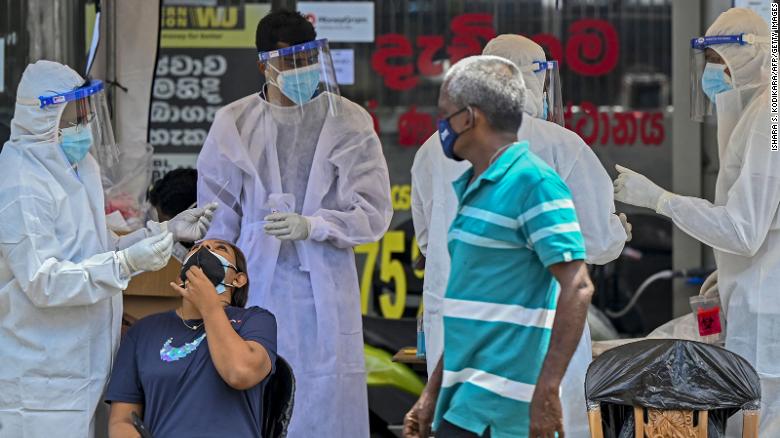As India’s coronavirus catastrophe worsens, new waves of infections are fast engulfing a growing number of nations across South and Southeast Asia — with some grappling with their worst outbreaks since the pandemic began.The World Health Organization (WHO) said on Wednesday that India had accounted for nearly half of all global infections and a quarter of deaths reported in the past week.
But cases have also skyrocketed in countries around India, from Nepal in the north to Sri Lanka and the Maldives in the south. And it’s not just India’s neighbors — further away in Southeast Asia, infections are also surging in Thailand, Cambodia and Indonesia.”The Southeast Asia region reported over 2.7 million new cases and over 25,000 new deaths, a 19% and a 48% increase respectively compared to the previous week,” the WHO said on Wednesday. “India is currently driving the vast majority of this upward trend.
“The rapid resurgence of the virus has placed enormous pressure on the health systems and medical supplies of these countries. Some have called for international assistance amid the deepening crisis. On Wednesday, the International Federation of Red Cross and Red Crescent Societies (IFRC) warned more must be done to stop the tragedy unfolding across Asia.
“We need to act now and we need to act fast to have any hope of containing this human catastrophe,” Alexander Matheou, the IFRC’s Asia-Pacific regional director, said in a statement. “This virus has no respect for borders and these variants are running rampant across Asia.”
“It is my hope and expectation that all citizens without any discrimination will join the Sinhala and Tamil New Year celebrations with fresh hopes, determination, and righteous thoughts,” he wrote.But infections started to spike soon afterward. On April 27, the country reported 1,111 new cases, the first time daily infections had surged past 1,000 since the pandemic began.
Authorities responded by shutting schools, banning private functions and imposing lockdowns in more than 100 areas across the country of 21 million people. But the restrictions failed to flatten the rising caseload. On Wednesday, Sri Lanka expanded its lockdowns to four more districts. As of now, lockdowns have been imposed in 13 of the country’s 25 administrative regions. Sri Lanka has seen a steep spike in coronavirus cases since mid-AprilDespite its close proximity to India, the Indian coronavirus variant had not beendetected in Sri Lanka as of last week, according to Dr. Chandima Jeewandara at the University of Sri Jayawardenapura, who leads a team that conducts genetic sequencing of Covid-19 in the country.
Sri Lanka has seen a steep spike in coronavirus cases since mid-AprilDespite its close proximity to India, the Indian coronavirus variant had not beendetected in Sri Lanka as of last week, according to Dr. Chandima Jeewandara at the University of Sri Jayawardenapura, who leads a team that conducts genetic sequencing of Covid-19 in the country.
Instead, the rapid increase in cases is blamed on the highly contagious variant B.1.1.7, which was first detected in the United Kingdom and is circulating in Sri Lanka, Jeewandara said.Last week, President Rajapaksa said the only answer the spiraling outbreak is vaccination. But Sri Lanka is facing a shortage of 600,000 doses of the AstraZeneca vaccine it ordered from the Serum Institute of India to complete the second round of its inoculation program.
So far, only a million vaccines doses have been administered in the country of 21 million — about five doses per 100 people. The rollout is slower than that of India, which has administered 12 doses per 100 people.On Thursday, Sri Lanka became the latest neighboring country to seal its borders with India, following Bangladesh and Nepal.
Flight passengers from India were banned from entering, and Sri Lanka’s navy said it had stepped up patrols to keep away Indian trawlers.
Sri Lanka
Sri Lanka has experienced a steep spike in coronavirus cases since mid-April, with infections quickly surpassing the peak of its previous wave in February. On Friday, the South Asian island nation reported 1,895 cases — almost five times the daily infections it was reporting in early April.
According to the country’s Health Minister Pavithra Wanniarachchi, the uptick in infections was due to the large gatherings for Sri Lanka’s New Year on April 13 and 14, during which people crowded the streets to celebrate and shop.Before the event, authorities seemed confident Covid-19 was under control, and encouraged the public to celebrate while adhering to health guidelines.
In a New Year message on April 12, President Gotabaya Rajapaksa said while the pandemic prevented Sri Lanka from celebrating the festival last year, “this year all of us together have made it possible to enjoy the New Year festivities.”

